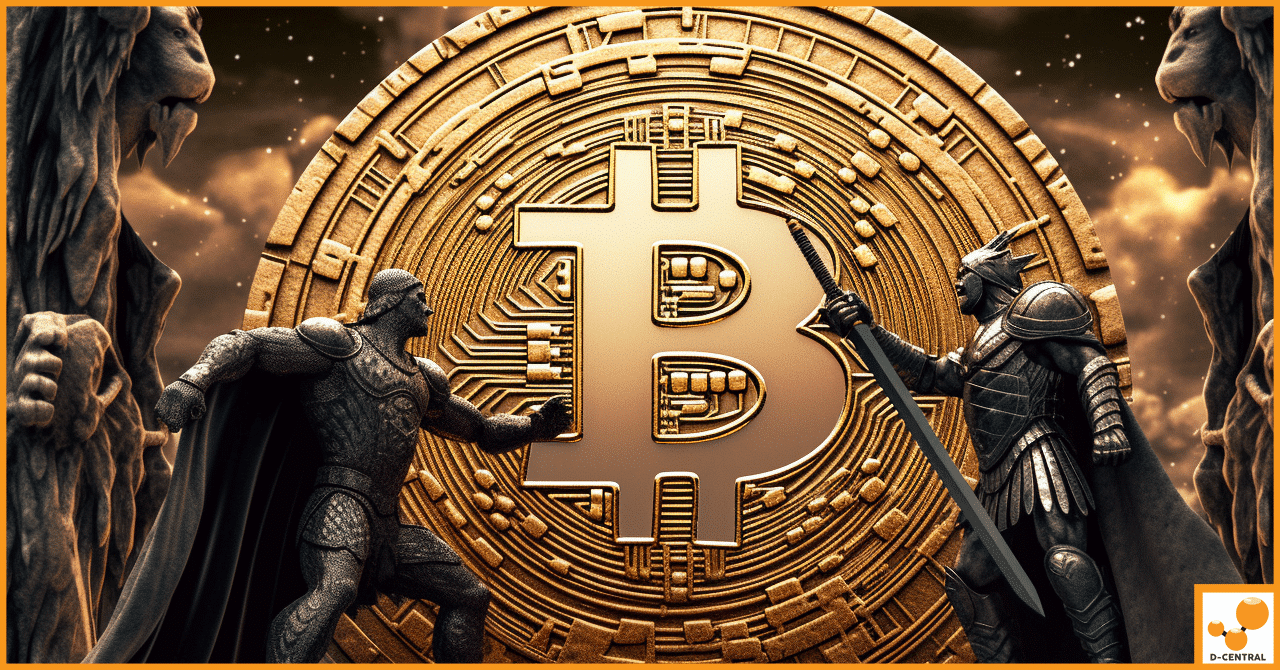
Why Bitcoin Stands Tall as the Sole Defender Against the Centralization of Digital Currencies
In the world of digital currencies, Bitcoin has always stood out as the pioneer of decentralization. Since its inception in
4479 Desserte Nord Autoroute 440, Laval, QC H7P 6E2

In the digital age, the concept of currency has evolved beyond physical money to include digital currencies, a revolutionary form of assets that exists purely in the digital realm. The inception of digital currencies marked the beginning of a new era in financial transactions, one that promises greater efficiency, security, and accessibility. Central to this revolution is blockchain technology, an ingenious invention that underpins the operation of all digital currencies.
Blockchain technology, with its decentralized ledger system, has emerged as a cornerstone for cryptocurrencies, offering a secure and transparent method for recording transactions. Unlike traditional banking systems that rely on central authorities, blockchain operates on a distributed network, ensuring that each transaction is immutable and transparent to all participants. This foundational technology not only enhances the security of digital transactions but also significantly reduces the cost and time involved in processing them.
The transformative potential of blockchain extends beyond mere transaction processing. It opens up new avenues for financial inclusion, enables the creation of decentralized financial (DeFi) services, and lays the groundwork for a future where financial transactions are more democratic, accessible, and secure. As we delve deeper into the role of blockchain technology in cryptocurrency transactions, it’s essential to appreciate its profound impact on reshaping the financial landscape, heralding a future where digital currencies play a pivotal role in global commerce.
Blockchain technology is a digital and decentralized ledger that records transactions across multiple computers in such a manner that the registered transactions cannot be altered retroactively. This technology is the backbone of cryptocurrency systems, providing a secure and transparent way to record transactions without the need for a central authority. At its core, blockchain operates on the principles of decentralization, transparency, and immutability.
The blockchain operates through a network of computers (nodes), each participating in the management and verification of transactions. Here’s a simplified breakdown of its mechanism:
Blockchain technology’s roots trace back to 1991 when researchers Stuart Haber and W. Scott Stornetta introduced a computationally practical solution for time-stamping digital documents so that they couldn’t be backdated or tampered with. However, it wasn’t until 2008 that blockchain gained prominence with the release of the Bitcoin whitepaper by an individual or group under the pseudonym Satoshi Nakamoto. Bitcoin introduced the first successful implementation of blockchain technology, enabling digital currency transactions without the need for a central authority.
This innovation sparked the development of numerous other cryptocurrencies and blockchain applications beyond digital currencies, such as smart contracts, decentralized finance (DeFi), and non-fungible tokens (NFTs). Over the years, blockchain technology has evolved from its initial use in cryptocurrency transactions to become a foundational technology with the potential to transform various industries by enabling secure, transparent, and efficient transactions.
Decentralization is the hallmark of blockchain technology, setting it apart from traditional centralized financial systems. At its essence, decentralization refers to the distribution of power away from a central authority, spreading it across a network of users. In the context of blockchain, this means that no single entity or organization controls the ledger or the data therein. Instead, the ledger is distributed across numerous nodes (computers) worldwide, each holding a copy of the entire blockchain. This architecture ensures that all transactions and data are recorded across this distributed network, making the information highly resistant to tampering, censorship, or control.
The decentralized nature of blockchain technology brings several significant advantages:
The decentralized model of blockchain represents a paradigm shift in how data is managed, verified, and transferred, offering a foundation for a more secure, transparent, and equitable digital world.
The transaction process in a blockchain involves several key steps, ensuring secure, transparent, and efficient transfer of digital assets like cryptocurrencies. Here’s how it typically unfolds:
Blockchain technology significantly enhances transaction security through several mechanisms:
Through these features, blockchain technology provides a robust framework for conducting cryptocurrency transactions, ensuring they are secure, private, and resistant to fraud. The decentralized, cryptographic, and immutable nature of blockchain makes it an ideal platform for the digital economy, where trust and security are paramount.
One of the most significant challenges facing blockchain networks, particularly those utilizing cryptocurrencies, is scalability. Scalability refers to a network’s ability to handle a growing amount of transactions efficiently. As blockchain networks like Bitcoin and Ethereum have grown in popularity, they’ve encountered limitations in processing capacity, leading to slower transaction times and higher fees during peak usage.
The root of the scalability issue lies in the size of blocks and the time it takes to add them to the blockchain. For example, Bitcoin’s block size is limited, and the network processes one block approximately every ten minutes. When transaction volumes exceed the block size, transactions queue up, waiting for inclusion in a block, which can lead to delays and increased transaction fees.
Several potential solutions have been proposed and implemented to address blockchain scalability issues:
Blockchain technology has undeniably revolutionized the landscape of cryptocurrency transactions, serving as the bedrock upon which the entire concept of digital currencies is built. Its introduction not only heralded a new era of financial transactions that are more secure, transparent, and efficient but also challenged traditional notions of monetary exchange and financial intermediation. By leveraging the principles of decentralization, immutability, and consensus, blockchain has enhanced the security and integrity of cryptocurrency transactions, making them nearly impervious to fraud and censorship.
The future potential of blockchain technology extends far beyond its current applications in cryptocurrencies. Ongoing developments in scalability solutions, such as Layer 2 protocols and sharding, promise to address some of the most pressing challenges faced by blockchain networks today. Moreover, the exploration of more energy-efficient consensus mechanisms like Proof of Stake (PoS) signifies a commitment to sustainability, crucial for the long-term adoption and growth of blockchain technologies.
As we look to the future, the continued evolution of blockchain technology will likely spur innovations across various sectors, from finance and supply chain management to healthcare and governance, potentially transforming the global economy in profound ways. The journey of blockchain is far from over; it is only just beginning, with each development bringing us closer to realizing the full extent of its transformative potential. The road ahead is ripe with possibilities, ready to be explored by those willing to venture into the new frontier of digital finance and beyond.
What is blockchain technology?
Blockchain technology is a digital and decentralized ledger that records transactions across multiple computers in a way that prevents retroactive alteration of the transaction history. It underpins cryptocurrencies, providing a secure and transparent way to record transactions without a central authority.
How does blockchain technology work?
Blockchain works through a network of computers (nodes), with each node holding a copy of the blockchain. Transactions are grouped in blocks, encrypted, and added to the blockchain through a process called mining, which involves solving complex mathematical puzzles.
What is the significance of blockchain technology in digital currencies?
Blockchain technology is the foundation of digital currencies, ensuring secure, transparent, and efficient financial transactions. It enables the operation of cryptocurrencies without needing centralized authorities, thereby enhancing security and reducing transaction costs.
What are the key features of blockchain technology?
The key features include decentralization, transparency, immutability, and the ability to operate in a trustless environment. These contribute to the security, integrity, and reliability of transactions conducted on the blockchain.
What are the challenges facing blockchain technology?
One of the primary challenges is scalability; as blockchain networks grow in popularity, limitations in processing capacity can lead to slower transaction times and higher fees. Solutions such as off-chain transactions, sharding, and Layer 2 scaling are being explored to address this.
What potential future applications does blockchain technology have beyond cryptocurrencies?
Blockchain technology has the potential to transform various sectors by enabling secure, transparent, and efficient transactions. Possible applications include supply chain management, healthcare, finance, and governance.
What are Layer 2 scaling solutions in blockchain technology?
Layer 2 scaling solutions are protocols that operate on top of an existing blockchain to increase transaction speed and reduce costs. They process transactions off-chain before settling them on the main blockchain, reducing the strain on the network.
DISCLAIMER: D-Central Technologies and its associated content, including this blog, do not serve as financial advisors or official investment advisors. The insights and opinions shared here or by any guests featured in our content are provided purely for informational and educational purposes. Such communications should not be interpreted as financial, investment, legal, tax, or any form of specific advice. We are committed to advancing the knowledge and understanding of Bitcoin and its potential impact on society. However, we urge our community to proceed with caution and informed judgment in all related endeavors.
Related Posts

In the world of digital currencies, Bitcoin has always stood out as the pioneer of decentralization. Since its inception in

Cryptocurrencies such as Bitcoin have the potential to revolutionize our financial systems, creating new opportunities for users and pushing us

The connection between Bitcoin and the Star Wars universe has long fascinated me. After years of exploration, reflection, and writing,